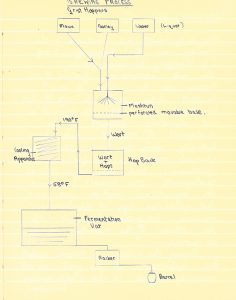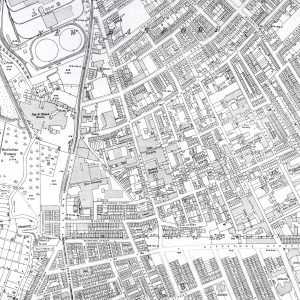March 30, 2023, by lzzre
A Toast to GeogSoc
A blog by Dr David Beckingham
Our Geographical Society is celebrating its centenary in 2023. The Society’s minute books are some of the oldest materials relating to departmental and student life in our archive. They record a range of activities, from talks to dances and trips to local industries. With research interests in British cultures of alcohol consumption and their regulation, one particular trip caught my attention.
On November 21st 1939, 12 members of the society toured the Shipstones Star Brewery, in New Basford. The students learnt about the different stages involved in brewing (see Figure 1), as well as coopering and bottling. They also visited the brewery’s air-raid shelter, ‘which was appropriately near the “Sample Room”.’ The word appropriately is interesting here: the shelter was a reminder – as if they would have needed it – that war interfered with the basics of everyday life, giving them new meaning.
Figure 1, Brewing Process
(School of Geography)
‘Certain members of the party now emanating a strange radiance’, the minutes read, ‘were entirely oblivious of the cold clammy nature of the bunter sandstone cellar’. Not so our reporter, it seems, who recorded a thorough locational geography of beer production. Here was sound educational evidence for their choice of excursion.
The brewery was located in the Leen valley. The brewery had previously used its own wells, but now relied on the city water supply. It ‘requires hardening (by addn of gypsum??? “burtonisation”)’, we read. Its high sulphate levels made Burton’s water ideal for brewing the pale hopped beers that made the town famous. Nottingham water, percolating through gypsum beds, also supported the historical reputation of its beer.
The other raw materials were barley (some English, some Californian and south American), maize (imported through Liverpool), and hops (chiefly from Kent, Herefordshire and Worcestershire). Beer was shipped in barrels made from Russian oak or in Staffordshire-made bottles.
Figure 2, Ordnance Survey, 1: 2500, Nottinghamshire 38.13, Edition of 1915, Reprint 40/42
The Star Brewery features on several maps in the collection. I have picked out sections from three sheets that all apparently reprinted around the Second World War. Figure 2 is a section from the 1: 2500 series. It is dated 1915, though the information on the map suggests it is one of 40 reprints from 1942. Its scale is excellent for identifying places of employment, such as textile factories and works, as well as churches and schools. The brewery is an impressive size when compared to the nearby terraces of housing.
Figure 3, Ordnance Survey, 6 inch to 1 mile, Nottinghamshire 38.SW, Edition of 1920, Reprint 150/41
Figures 3 and 4 are six inch to one-mile surveys. They are worth comparing. Figure 3 is a 1920 edition, stamped “E” Company, 1st NOTTS (City) Battalion HOME GUARD. It appears to have reprinted as late as 1941, but this point a series of developments had taken place in the city. Some are shown on Figure 4.
Figure 4, Ordnance Survey, 6 inch to 1 mile, Nottinghamshire 38 SW, Provisional Edition, Revision of 1919 with additions in 1938
Figure 4 was a provisional edition map. Its boundaries were correct to 1919, with additions made in 1938. According to information on the sheet, these were ‘surveyed by rapid methods as an emergency measure’. Noteworthy here is the growth of New Basford to the west of the brewery, and the expansion north and west around Sherwood. The map also shows Western Boulevard and Valley Road, which form today’s A6514 ring road.
In different ways, the maps demonstrate the broader appetite for cartographic information that accompanied the outbreak of war. When the students gathered for their Freshers’ social in October of 1940 – a dance accompanied by the College Band – men were ‘in a sad minority’. A similar tempering feeling accompanies the minutes of the society’s annual dance in May 1941. Facing down their ‘wartime difficulties’, about 130 gathered at the Welbeck Hotel for ‘a very enjoyable evening’. However, ‘the absence of many old faces was very much regretted’.
Ordnance Survey items held by the School of Geography are catalogued in NUsearch. To consult them, contact collection curator Elaine Watts.
No comments yet, fill out a comment to be the first





Leave a Reply